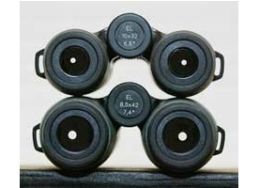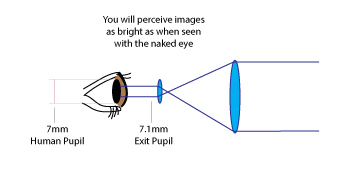What is Exit Pupil In Hunting Optics?
- Posted By Jeff Byrnes
- Blog
 In an optical device, the exit pupil is a virtual aperture. On a pair of binoculars, for example, it can be seen as the bright circle in the center of each eyepiece when you hold them about a foot away from your eyes with the objective lenses pointed towards a bright light.
In an optical device, the exit pupil is a virtual aperture. On a pair of binoculars, for example, it can be seen as the bright circle in the center of each eyepiece when you hold them about a foot away from your eyes with the objective lenses pointed towards a bright light.
The Importance of the Exit Pupil
Light rays must pass through this virtual aperture to exit the optical system and enter your eyes. The larger the exit pupil, then, the more light will be transmitted to your eyes. This is why exit pupil is an important characteristic to consider when choosing hunting optics, especially for use in the poor lighting conditions found at dawn or dusk.
How the Exit Pupil is Calculated
The exit pupil is the effective diameter of the objective lens divided by the magnification. For example:
8×42 Binoculars The formula would be 42 ÷ 8 = 5.3, giving the exit pupil a 5.3mm diameter.
10×42 Binoculars For this pair of binoculars, our formula is 42 ÷ 10 = 4.2. Thus, the diameter of our exit pupil is 4.2mm, showing that an 8×42 pair of binoculars would be a better choice than a 10×42 pair, all else being equal.
8×56 Binoculars The formula here would be 56 ÷ 8 = 7, leaving an exit pupil of 7mm. This just happens to be the maximum pupil aperture of the human eye, which will be important in determining just how much of an exit pupil is too much.
That’s Not the Whole Story, Though
You might think that bigger is always better when it comes to exit pupil, but there is such a thing as an exit pupil that is too big. Sometimes, a large exit pupil won’t make any difference at all, because it is larger than the human pupil’s largest diameter (7mm).
With different light conditions, the human pupil expands and contracts. * In daylight, with good lighting conditions, it opens up to approximately 2mm to 4mm * In dark lighting conditions, the maximum pupil size for the human eye is between 5mm and 9mm for people below 25 years of age, and decreases slowly with age. The average human’s pupil size is 7mm at its widest opening.
What does this mean? Let’s take a look at a pair of 7×50 binoculars, for example. Given a 2–3mm pupil diameter during bright light, and exit pupil of the binoculars of 7.1mm (because 50 ÷ 7 = 7.1), the binoculars exit pupil is larger than your own pupil. This means more than half of the light will be blocked by your iris, never reaching the retina. In bright conditions, this won’t be significant because there is so much light to begin with.
In low light conditions, it’s a completely different animal. Look at what happens with a pair of 8×20 binoculars, for example. As you can see, the 2.5mm exit pupil of the binoculars is much smaller than the 7mm diameter of the human pupil, so you will perceive the image as dark.

On the other hand, a pair of 7×50 binoculars has an exit pupil of 7.1mm. Because the diameter of the human pupil is 7mm, about the same size as that of the binoculars, you will perceive images as bright as if viewed with the naked eyes.

This post was written by Jeff Byrnes
Hi there! I’m Jeff, an avid outdoorsman and hunter who really likes exploring new technology. I’m especially into hunting optics, which is why I’m writing these reviews! I hope you find my articles helpful in your own shooting and hunting.








